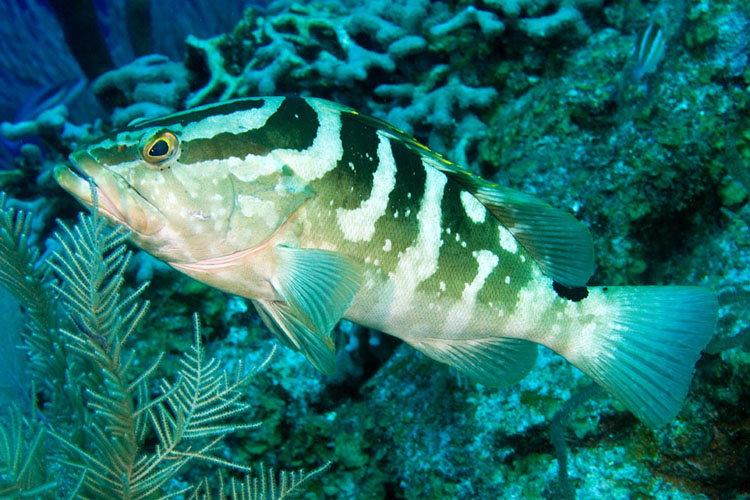How Important Is It to Limit Reef Fishing Locations and Seasons?

New science shows conservation strategies have worked to rebuild the Nassau grouper population.
Last week, NOAA Fisheries announced regulatory changes for the snapper-grouper fishery of the South Atlantic Region. On Feb. 26, modified commercial regulations take effect for several species: blueline tilefish, snowy grouper, greater amberjack, red porgy, vermilion snapper, lesser amberjack, almaco jack, banded rudderfish, queen snapper, silk snapper, blackfin snapper, and gray triggerfish. These new rules put in place conservation strategies that change commercial fishing seasons, numbers of fish allowed to be harvested per trip, and minimum sizes.
Many reef fishes, including several species of grouper, gather by the thousands to spawn, forming “fish-spawning aggregations” (FSAs). Typically, fish spend a week or more at FSAs. Because reproduction for a fish population usually happens within a short window of time and at a single location, intense fishing where fish aggregate to spawn can affect the stock more substantially than would harvesting from other areas. Impacts often include smaller fish or — particularly for hermaphroditic species — different ratios of males to females.
Research Need
Because some fish populations depend on FSAs, fishery managers in many locations have established marine protected areas or seasonal closures to help such stocks recover. The challenge in assessing management effectiveness lies largely in the development of accurate estimates to track stock size through time. Last month, however, a research team published the first evidence about whether such protective measures would prove successful long-term.
What did they study?
The Nassau grouper, once the most important reef fishery in the Caribbean, best exemplifies the risks associated with targeted fishing on FSAs. In fact, this fish’s dramatic population decline resulted in a “threatened” designation under the U.S. Endangered Species Act.
Since 2005, the Reef Environmental Education Foundation and the Cayman Islands Department of Environment have monitored Nassau grouper through the collaborative Grouper Moon Project. As a result, researchers could study this fish to understand better whether a population that had experienced such a collapse could even rebound through fisheries management.
The project took a novel two-pronged approach that included monitoring by tagging and video to more accurately estimate annual numbers of Nassau grouper populations, and, thus, provide insight into the effects of conservation efforts.
What did they find?
With data from the Grouper Moon Project, scientists could develop a population model for the species across an entire decade. They published their seminal results earlier this year in the Proceedings of the National Academy of Science.
The team found that Nassau grouper have undergone a remarkable recovery during the study period. Over the last ten years, the population on Little Cayman has more than quintupled in response to conservation efforts, from about 1,200 fish in 2009 to over 7,000 in 2018. Less census data exists for the Cayman Brac population, but those findings show a similar pattern.
There are lots of possible factors involved in how populations can rebound (or not), and the researchers’ published findings include more data about the ins and outs of the project. This study demonstrates, however, that conservation success in building aggregation-based fisheries can result from regulating fishing locations and seasonal closures.
Anything else?
During the project, divers tagged 934 fish, and the team sighted no fish outside the island’s waters where they had tagged it.
Reading
Waterhouse, L., Heppell, S.A., Pattengill-Semmens, C.V., McCoy, C., Bush, P., Johnson, B.C., and B.X. Semmens. 2020. “Recovery of critically endangered Nassau grouper (Epinephelus striatus) in the Cayman Islands following targeted conservation actions.” Proceedings of the National Academy of Sciences. 117 (3) 1587-1595.
The project was made possible through funding from the Lenfest Ocean Program, the Disney Conservation Fund, NOAA International Coral Reef Conservation Program (Grant No. NA04NOS4630287), P. Hillenbrand, and the J. Edward Mahoney Foundation. L.W. was funded by the NOAA Fisheries-Sea Grant Joint Fellowship Program in Population and Ecosystem Dynamics (Grant No. NA13OAR4170110 E/PD-11) and the Philanthropic Educational Organization Scholar Award.
Summary by Sara Mirabilio
Photo: Naussau Grouper, NOAA.
The text from Hook, Line & Science is available to reprint and republish, but only in its entirety and with this attribution: Hook, Line & Science, courtesy of Scott Baker and Sara Mirabilio, North Carolina Sea Grant. HookLineScience.com
- Categories:



